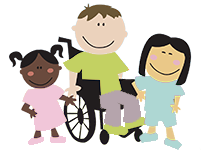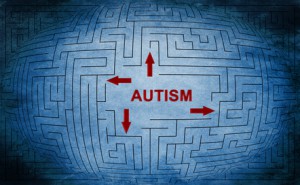You have just found out that your toddler has an autism spectrum disorder. Just hearing the diagnosis is overwhelming and frightening. We all have dreams of a happy childhood and bright future for our offspring. How will your life change and what should you do first?
Initially, you need to give yourself and your family a little time to take in the diagnosis, do some research and network with support organizations. But after a short while, it is time to start putting the critical therapies in place that make such an important impact on your child’s present and future quality of life. And though these treatments will change your family routine and impact your finances, it is important to move forward providing the most you can within your resources, because autism will change your life regardless of how you respond. You want to have change that will be beneficial, not just leave you feeling hopeless.
As a parent of an adult with autism, I have moved through many stages of grief, many different treatments and therapies, and several community support services, such as the school district and waiver services provided by Texas Health and Human Services Commission (HHSC). Over the past 30 years, I have seen certain assumptions remain true:
● One is that children with ASD, particularly young children, need intensive treatment, at least 25 hours a week.
● Second, the interventions should be individualized based on a unique profile
● Third, treatment must be structured.
● Fourth, for young children as well as many older individuals, there needs to be a small ratio of trainer(or therapist, or parent) to child.
Each child is unique and the goals that one child may need to address will often be very different from the goals of another child with autism. Each child will need many opportunities to learn and practice new skills before they are internalized and start to generalize. This all requires intensity, individualization, structure and a small ratio.
Though I have experienced these truths and learned about them through education and specialized training, we also have a growing body of research highlighting methodologies that are successful in treating autism, as measured by increasing appropriate skills and decreasing the characteristics of ASD.
Since Speech & Occupational Therapy of North Texas specializes in pediatric therapies, this article will highlight some of the treatment strategies that a parent would expect to see and learn from pediatric speech and occupational therapists working with children on the spectrum. Many of the strategies we use originate from behavioral and developmental understanding and can be found in many current evidence based approaches. We know that the skill, experience and style of a child’s speech therapist or occupational therapist are key to the effectiveness of whatever intervention is used. In Plano speech therapy and occupational therapy for autism are available in our East Plano Clinic. In McKinney speech therapy and occupational therapy for autism are available at our Stonebridge area location. Each of these clinics are located near or within an ABA Clinic so that we can work closely as a team to help our clients. Our therapists at our Frisco location are also highly experienced with children on the spectrum.
Strategies from Applied Behavior Analysis (ABA)
ABA programs and strategies originated in behavior modification science derived from the work of B.F. Skinner in the 1940s . Lovaas then started applying these principles to treating individuals with autism in the 1960’s. A basic premise of applied behavior analysis is that behaviors have a cause (antecedent) and a consequence (what happens as the result of the behavior). Based on the theory of operant conditioning, behaviors will increase if they are reinforced by positive consequences (positive for the individual in question). This is typically referred to as the ABC’s (antecedent-behavior-consequence). We all go through this chain of behavior throughout the day. What makes it so beneficial for teaching is to understand the power attached to manipulating the antecedents and consequences. For instance, if a child always runs to sit on the couch in front of the TV (behavior) when a parent holds up his favorite movie video (antecedent), because the child knows he will see the video (consequence of behavior) you can see that changing the antecedent may not result in the same behavior.
So it becomes important to identify positive reinforcers for a child (anything that increases the positive consequence) and negative reinforcers (anything that increases unwanted responses). Speech language pathologists and occupational therapists are very aware of the importance of positive reinforcement and the use of personally meaningful reinforcement in treatment activities as well as the importance of not reinforcing non-desired behaviors. Professionals who have experience with autism know the importance of structuring therapy to manipulate and analyze this A-B-C continuum. Speech pathologists and occupational therapists may focus on specific goals within their scope of practice, but they set up multiple opportunities to elicit desired behaviors through the use of positive reinforcement. These therapists demonstrate strategies for families and also work closely with other professionals whenever possible, to encourage carryover of skills.
Pivotal Response Treatment (PRT)
This treatment, which is based on the principles of ABA, was developed by Drs. Robert and Lynn Koegel in the 1970s. Pivotal Response Treatment focuses on pivotal behaviors that impact a wide range of actions – with motivation and initiation of communication being the primary pivotal behaviors addressed. This method is more child-directed than traditional ABA, following a child’s interest in the activities and toys used in therapy. Therapy will use both a structured and unstructured format, depending on the goal. Speech language pathologists and occupational therapists used child directed activities frequently since this increases the motivation of the child to interact and attend. Therapists can use knowledge of favorite activities to reinforce new learning. For example, if the goal is to have a child join you in a turn taking activity, a favored stuffed animal may be used to model the desired activity. Or teaching the concept of “where” by putting favored farm animal manipulatives in a box and then asking, “Where is the cow?”
Verbal Behavior (VB)
Verbal Behavior, another practiced based on applied behavior analysis, was developed by B.F. Skinner in the 1950s. VB applies ABA principles more specifically to teaching language, grouping language into operants (responses) with different functions. The most important operants in Verbal Behavior are echoics (imitation), mands (requests), tacts (labels) and intraverbals (social language, such as a response). More importance is placed on mands than tacts because there is a stronger connection between the word and it’s meaning when requesting. Speech language pathologists may not use the same terminology, but often use behavioral principles to encourage imitation, requesting , labeling and interactions.
Early Start Denver Model (ESDM)
The Early Start Denver Model is a developmental, relationship-based intervention that uses strategies consistent with ABA. This approach looks at all developmental domains. The methodology focuses on capturing a child’s attention through the use of enjoyable routines, using joint play as the catalyst for treatment. These play based activities are used to develop nonverbal and verbal communication, as well as turn-taking routines (which serve as the basis for communication exchanges). Speech language pathologists and occupational therapists typically use play based activities and play routines to foster communication, attention and learning. These strategies are often the heart and soul of intervention for young children in speech therapy, where the focus is on encouraging interaction using personally meaningful activities.
All of these treatment models used with autism require the intensity, structure, individualization and low teacher/child ratio to different degrees. Training is important and families are an important part of the process. Therapists should always provide support and training to families to increase the generalization of new skills across all settings.
Life is different with autism. As I look back I have found it more meaningful. The skills I learned for and from my son and through my profession as a speech language pathologist have made me a better mother as well as a better therapist. I also developed a better sense of humor as well as more patience and compassion. I also learned to be more organized and intentional. I wish my son didn’t have to live with the struggles of autism, but I am so proud of the great progress he has made and of the wonderful young man he has become.
If we can help your family and your child, please contact us at 972-424-0148. We are network providers for most major insurances. Visit our resource page to learn about grants and Government programs.

